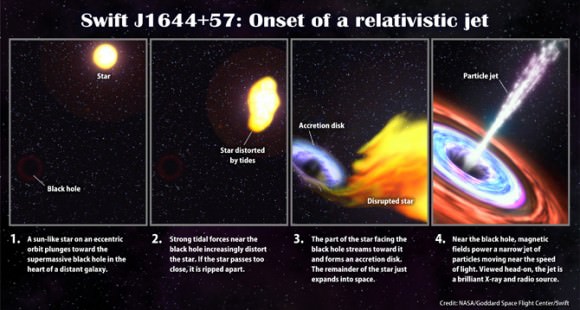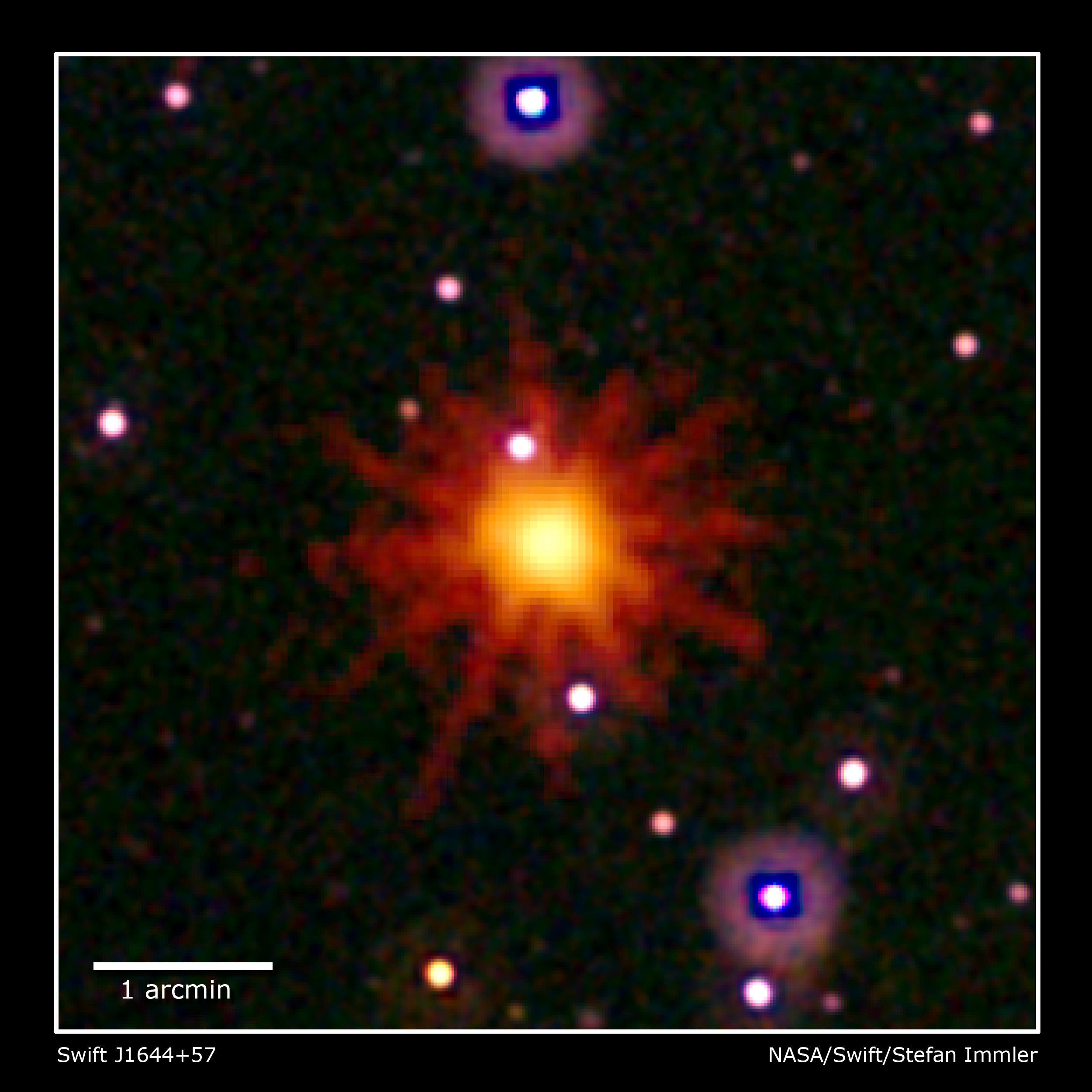Back in June we reported on the black hole that devoured a star and then hurled the x-ray energy across billions of light years, right at Earth. It was such a spectacular and unprecedented event, that more studies have been done on the source, known as Swift J1644+57, and the folks at the Goddard Space Flight Center mulitmedia team have produced an animation (above) of what the event may have looked like. Two new papers were published yesterday in Nature; one from a group at NASA studying the data from the Swift satellite and the Japanese Monitor of All-sky X-ray Image (MAXI) instrument aboard the International Space Station, and the other from scientists using ground-based observatories.
They have confirmed what happened was the result of a truly extraordinary event — the awakening of a distant galaxy’s dormant black hole as it shredded, sucked and consumed a star, and the X-ray burst was akin to the death screams of the star.
[/caption]
In the new studies, detailed analysis of MAXI and Swift observations revealed this was the first time that a nucleus with no previous X-ray emission had ever suddenly started such activity. The strong X-ray and rapid variation indicated that the X-ray came from a jet that was pointed right at Earth.
“Incredibly, this source is still producing X-rays and may remain bright enough for Swift to observe into next year,” said David Burrows, professor of astronomy at Penn State University and lead scientist for Swift’s X-Ray Telescope instrument. “It behaves unlike anything we’ve seen before.”
The galaxy is so far away, it took the light from the event approximately 3.9 billion years to reach Earth (that distance was updated from the 3.8 billion light years reported in June).
The black hole in the galaxy hosting Swift J1644+57, located in the constellation Draco, may be twice the mass of the four-million-solar-mass black hole in the center of the Milky Way galaxy. As a star falls toward a black hole, it is ripped apart by intense tides. The gas is corralled into a disk that swirls around the black hole and becomes rapidly heated to temperatures of millions of degrees.
The innermost gas in the disk spirals toward the black hole, where rapid motion and magnetism create dual, oppositely directed “funnels” through which some particles may escape. Jets driving matter at velocities greater than 90 percent the speed of light form along the black hole’s spin axis.

The Swift satellite detected flares from this region back on March 28, 2011, and the flares were initially assumed to signal a gamma-ray burst, one of the nearly daily short blasts of high-energy radiation often associated with the death of a massive star and the birth of a black hole in the distant universe. But as the emission continued to brighten and flare, astronomers realized that the most plausible explanation was the tidal disruption of a sun-like star seen as beamed emission.
“The radio emission occurs when the outgoing jet slams into the interstellar environment, and by contrast, the X-rays arise much closer to the black hole, likely near the base of the jet,” said Ashley Zauderer, from the Harvard-Smithsonian Center for Astrophysics in Cambridge, Mass, lead author of a study of the event from numerous ground-based radio observatories, including the National Radio Astronomy Observatory’s Expanded Very Large Array (EVLA) near Socorro, N.M.
“Our observations show that the radio-emitting region is still expanding at more than half the speed of light,” said Edo Berger, an associate professor of astrophysics at Harvard and a coauthor of the radio paper. “By tracking this expansion backward in time, we can confirm that the outflow formed at the same time as the Swift X-ray source.”
Swift launched in November 2004 and MAXI is mounted on the Japanese Kibo module on the ISS (installed in July 2009) and has been monitoring the whole sky since August 2009.
See more images and animations at the Goddard Space Flight Center Multimedia page.
Sources: Nature, JAXA, NASA


I believe the x ray emitted is more akin to the sound and sparkles of bones being crushed…
A possible second example of a tidally disrupted star, dubbed Sw J2058+05, was recently discussed in a paper on arXiv: http://arxiv.org/PS_cache/arxiv/pdf/1107/1107.5307v1.pdf
It will be interesting to see how common (or not) these events turn out to be.
Here are two more relevant papers (PDF):
The Birth of a Relativistic Outflow in the Unusual ?-ray Transient Swift J164449.3+573451;
Discovery of the Onset of Rapid Accretion by a Dormant Massive Black Hole.
Thanks for those links, Ivan. Here are a few more papers on Sw1644 I’ve ran across:
http://arxiv.org/PS_cache/arxiv/pdf/1105/1105.3209v1.pdf
http://arxiv.org/PS_cache/arxiv/pdf/1104/1104.4685v3.pdf
http://arxiv.org/PS_cache/arxiv/pdf/1104/1104.3290v1.pdf
http://arxiv.org/PS_cache/arxiv/pdf/1105/1105.2816v3.pdf
http://arxiv.org/PS_cache/arxiv/pdf/1104/1104.2528v2.pdf
http://arxiv.org/PS_cache/arxiv/pdf/1104/1104.3356v1.pdf
http://arxiv.org/PS_cache/arxiv/pdf/1104/1104.3257v1.pdf
There’s obviously a lot of interest in this (and similar) event(s). 😉
Wow! Thanks a lot, Jon!
Goodbye any planetary systems around that star. spaghettified!
The Ricci curvature for a Schwarzschild black hole is zero and so the Riemann curvatures are pure Weyl curvatures. This is a part of the general relativity “lore” of black holes. The most relevant curvature term is R^r_{trt} = 2GM/r^3. The distortion of a body of length L = U^r is distored by the Riemannian curvature
d^2U^r/ds^2 = R^r_{trt}U^tU^rU^t,
where this equation is the geodesic deviation equation. It tells how two freely falling objects separated by some vector, here U^r = L, accelerate apart from each other. A few Schwarzschild radii r_s = 2GM/c^2 the time vector U^t ~= 1 (relativistic effects comparatively small) and ds =~ds. We then can compute the relative accelerates of the ends of a rod of length L
d^2L/dt^2 = 2GML/r^3.
For those familiar with Newtonian gravity this result is identical to the tidal force, where the assumptions used recover Newton’s results.
A black hole with about 8 million solar masses has a Schwarzschild radius of about 10 million km. We may assume the rod length is equal to the diameter of this star ~ 1million km. I will calculate this tidal for r = 10L. The acceleration is .9km/sec^2 or 900m/s^2. So the acceleration induced by the tidal force is quite large. The surface gravity on the sun is 274m/s^2, so clearly the surface of a sun-like star can be pulled away, which will continue unabated if the star proceeds closer to the BH. Once the sun-like star gets within 15×10^6km (15L) of the black hole the tidal acceleration of a particle on the leading edge of the star is equal to the gravitational acceleration of the star.
LC
Something I don’t understand in the animation is how part of the gas suddenly gets a 90 degree turn and gets sucked in. Magnetic field lines?
The star which is distended is at the perigee of an orbit and the material which falls in due to tidal interaction falls closer to the BH and by a Kepler argument must move faster as it gets closer to the BH. There are also hydrodynamic issues as well. I presume this video clip is based on some hydrocode result.
LC
It’s a strange thought to think of a star being ripped apart. Bye bye star.